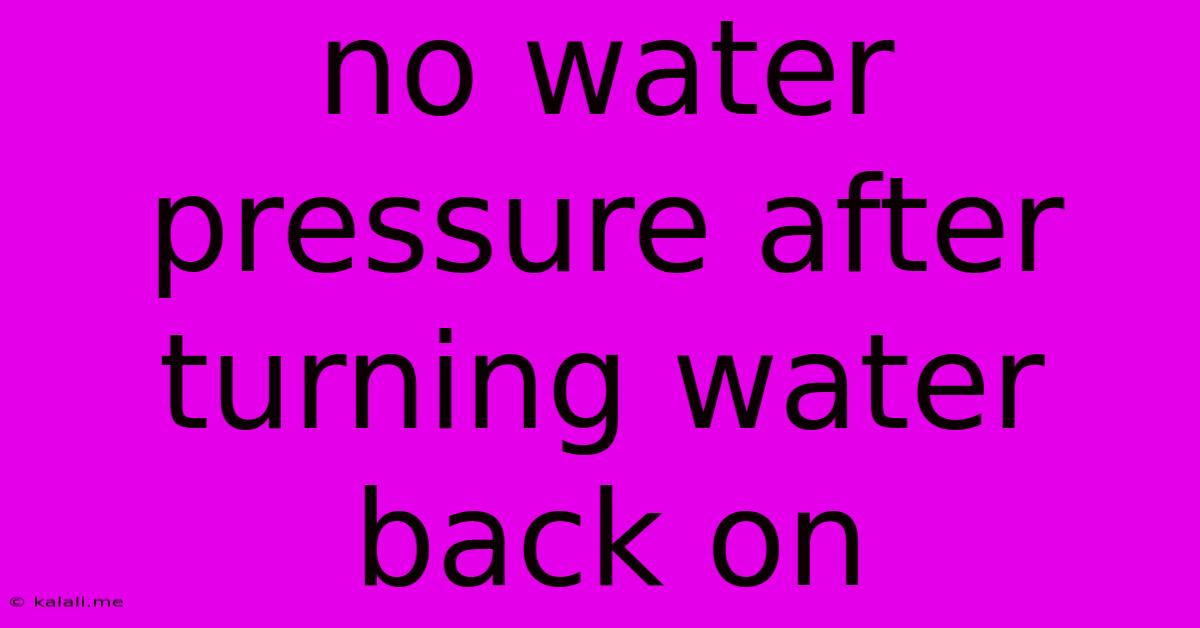No Water Pressure After Turning Water Back On
Kalali
Jun 06, 2025 · 3 min read

Table of Contents
No Water Pressure After Turning Water Back On: Troubleshooting Guide
Meta Description: Experiencing low water pressure after restoring your water supply? This comprehensive guide helps you troubleshoot the problem, from simple fixes to more complex issues, ensuring you get your water pressure back to normal quickly.
Have you ever experienced the frustration of turning your water back on after a planned outage or repair, only to find that the water pressure is significantly lower than usual, or even nonexistent? This is a common problem with several potential causes, ranging from simple fixes you can handle yourself to more complex issues requiring a professional plumber. This guide will walk you through the troubleshooting process, helping you identify the problem and restore your water pressure efficiently.
Common Causes of Low Water Pressure After Water Restoration
Several factors can contribute to low water pressure after a water supply interruption. Here are some of the most common culprits:
-
Air in the Lines: This is often the most frequent reason for low pressure. When the water supply is interrupted, air can enter the pipes. This air needs to be purged from the system.
-
Sediment Buildup: Over time, sediment and mineral deposits can accumulate inside your pipes, restricting water flow and reducing pressure.
-
Faulty Pressure Regulator: This device controls the water pressure entering your home. A malfunctioning regulator can result in low or inconsistent pressure.
-
Leaking Pipes: A leak, even a small one, can significantly impact overall water pressure throughout your home. The leak can be anywhere in your plumbing system, from the main line to individual fixtures.
-
Clogged Pipes: Similar to sediment buildup, clogs within your pipes, perhaps caused by debris or corrosion, can severely restrict water flow.
-
Problems with the Main Water Line: Issues with the main water line supplying water to your house, whether it’s a blockage, damage, or a problem with the municipality's water supply, can drastically affect water pressure.
Troubleshooting Steps: Diagnosing the Problem
Before calling a plumber, try these troubleshooting steps:
1. Check Your Entire House: Is the low water pressure affecting all faucets and appliances, or just some? This helps pinpoint the source of the problem. If it's only one fixture, the problem is likely localized to that area.
2. Run Multiple Faucets Simultaneously: Open several faucets (hot and cold) at once. If the pressure increases at one or more while others decrease, it might suggest a blockage closer to the affected faucets.
3. Check Your Water Meter: Locate your water meter (usually outside your home) and check if the indicator is moving. If it's not moving, there might be a problem with the main water supply to your home. Contact your local water utility company.
4. Purge Air from the Lines: Turn on all faucets, starting with the highest fixtures in your house, and let them run for several minutes. The force of the water should help expel trapped air.
5. Examine Faucet Aerators and Showerheads: Remove and clean any aerators and showerheads; mineral deposits or debris can significantly reduce water flow.
6. Listen for Unusual Sounds: Pay attention to unusual sounds like gurgling or hammering (water hammer) coming from your pipes. These can indicate issues requiring professional attention.
When to Call a Plumber
If the above steps don't restore your water pressure, it's time to call a qualified plumber. They have the tools and expertise to diagnose and fix more complex problems, such as:
- Leaking pipes: Identifying and repairing leaks is critical to maintaining sufficient water pressure and preventing further damage.
- Faulty pressure regulator: Replacing or repairing this critical component requires professional knowledge.
- Major pipe blockages: Clearing significant blockages may necessitate specialized equipment.
- Problems with the main water line: This is typically beyond the scope of a homeowner's capabilities.
By following this guide and systematically troubleshooting the problem, you can effectively address low water pressure after restoring your water supply. Remember that addressing the issue promptly prevents further damage and ensures you have consistent and adequate water pressure in your home.
Latest Posts
Latest Posts
-
Urine Stains Smells Around Toilet Base
Jun 06, 2025
-
Satellite Rhel 8 10 Update Breaks Services
Jun 06, 2025
-
Fallout 4 Do Bobbleheads Increase Special Past 10
Jun 06, 2025
-
What Is It Called When A Plant Starts To Die
Jun 06, 2025
-
Can Hoe Can Be Sweep On Minecraft Java
Jun 06, 2025
Related Post
Thank you for visiting our website which covers about No Water Pressure After Turning Water Back On . We hope the information provided has been useful to you. Feel free to contact us if you have any questions or need further assistance. See you next time and don't miss to bookmark.